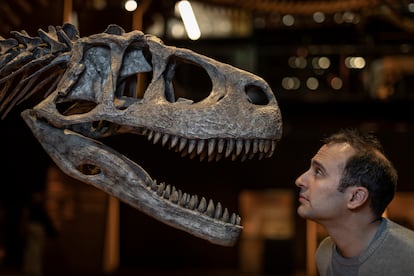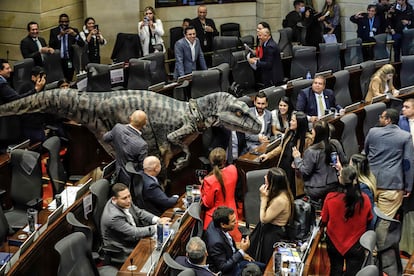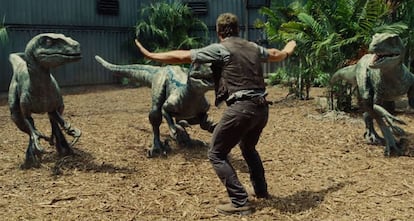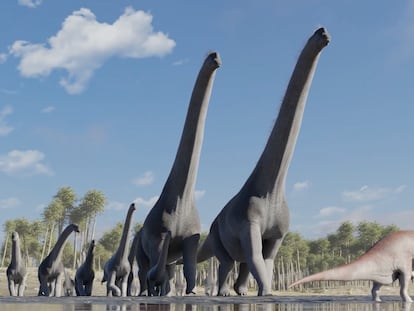Steve Brusatte, paleontologist: ‘The most terrifying thing about the tyrannosaurus was not its jaws but its intelligence’
The American scientist, a rising star in the study of dinosaurs, talks to EL PAÍS about what would have happened to the species if they had not been wiped out by the asteroid


Steve Brusatte, 39, is the rising star of world paleontology, although given his vitalistic nature, overflowing and contagious enthusiasm and fiery passion (and that his favorite subject is dinosaurs, of course), he could also be seen as an asteroid. In this case, not a devastating celestial body like the one that caused the extinction of the dinosaurs, but a sparkling and friendly asteroid that brings them back to us, wrapped in surprises.
Brusatte — author of one of the most interesting recent books on the extraordinary creatures, Rise and Fall of the Dinosaurs — visited Barcelona to take part in activities held as part of the exhibition Dinosaurs of Patagonia at the Science Museum in Barcelona. Doctor in Environmental and Earth Sciences from Columbia University and a graduate in Earth Sciences and Paleobiology from Bristol University, Brusatte — who learned under Paul Sereno — is currently Professor of Paleontology at the University of Edinburgh. He has described 15 new species of fossils (such as Zhenyuanlong suni) and is the author of a dozen books and more than 110 scientific publications. He has also acted as an advisor on BBC documentaries, such as Walking with Dinosaurs, and on the final film in the Jurassic Park saga, Jurassic World: Dominion. When the original movie came out, he was just nine years old. He has a real obsession with tyrannosaurs, on which he is an expert.
Question. What would be our impression of a Tyrannosaurus rex, an iconic T. Rex?
Answer. Terrifying! We wouldn’t be able to stop trembling with terror! We would feel something similar to when we see one of the preserved skeletons of the king. It gives us some sense of the size, power and ferocity of that animal. With that huge head and those jaws that you can fit inside. The most incredible thing is that T. Rex, the king of the dinosaurs, the largest predator that has ever lived on land on the planet, was not a monster, or not just a monster, but also a real, magnificent animal. It was not at all a brute beast, but a very complex creature with as much power as brains. Quite an intelligent animal. That makes it even more terrifying: more than the bone-crushing jaws with its teeth like banana-sized railroad spikes, the intelligence. In fact, what the first Jurassic Park showed, that if you stood still, the Tyrannosaurius Rex could not perceive you is pure nonsense. Standing still in front of a T. Rex would have been suicidal!
Q. That’s definitely important to know. You compare the T. Rex to a chimpanzee because of its intelligence.
A. What I meant was that because of its intelligence it was the dinosaur version of a chimpanzee, not that it was as intelligent as a chimpanzee. However, tyrannosaurses, of which we have discovered almost 20 new species in the last 15 years, are undoubtedly among the most intelligent dinosaurs, like raptors and birds. Some of today’s birds are extraordinarily intelligent, such as crows and parakeets. We can compare the intelligence of these birds with that of the tyrannosaurs. I’ve seen amazing tests with those birds, the way they react...
Q. Do we already know for sure why the T. Rex had such small arms?
A. I don’t know if we have the complete answer, but we are working on it. Basically it seems that the T. Rex went from having human-sized ancestors to something huge. As their head grew gigantically, their arms got smaller. The jaws played the role of hands and the arms didn’t have to be big. But they were still there, they didn’t disappear. Whales have lost their arms, but the T. Rex did not. If they had been completely useless those limbs would have disappeared, and yet they are there, and they are very muscular, like human arms but much stronger. So strong that they allowed it to grab. We think they were doing something with them. Maybe they grabbed the prey to stabilize it while biting it, or they used them in some way in mating.

Q. You maintain that dinosaurs were in top form when they became extinct at the end of the Cretaceous period, 66 million years ago. How may they have evolved if it weren’t for the asteroid?
A. At the time of the impact, equivalent to a billion nuclear bombs, there were many dinosaurs, they had ruled the world for 150 million years, they had survived many events — heat and cold, volcanoes, rising seas, the fragmentation of the continent Pangea — and seemed capable of managing everything that nature threw at them. They were not at all the pathetic, slow and stupid beings that we were led to believe years ago, a dead end of evolution. So if it had not been for the asteroid they would be the dominant ones today, there is no doubt in my mind. They would have continued to evolve. The T. Rex would not be the same, it would have continued to adapt. There’s no reason it wouldn’t have continued to grow. How far? Well, there are physical and biomechanical limitations, of course, but there were undoubtedly some larger ones than the ones we found, measuring 13 meters long and weighing 8 tons. They could have continued to increase their mass. The imagination has a free reign, and so do our nightmares!
Q. A T. has egg not yet been found yet...
A. Ah, if I could make one wish, if I could choose to find something, it would be to find a T Rex. egg. It is almost certain that they laid them, because all the animals that are in their phylogenetic line did so. Why haven’t we found them? A fossil is a miracle. We simply haven’t found them. Perhaps they nested in areas that were not good for fossilizing. Eggs are usually kept in sandy areas, perhaps the T. Rex nests in the mountains. Another possibility is that they laid soft eggs, like some reptiles, that were difficult to fossilize.
Q. They grew very quickly.
A. Yes. Since we don’t have eggs we don’t know what size they started at, but surely their eggs were no bigger than those of an ostrich, maybe like a soccer ball, but not much bigger. A baby T. Rex was small, and it grew fast, very fast. And it accelerated, it gained two or three kilos a day. We know this from the growth rings on their bones. They went from being a baby that fit in your hand to a monster. Curiously, we never found specimens older than 30 years. If I were a T. Rex, I would have died a decade ago by now.
Q. Why did they die so young?
A. Did they live dangerously? Like a James Dean from the Cretaceous? I don’t know. Normally larger animals, as happens among mammals, live longer. But it is likely that the life of the T. Rex was very tough. It was very difficult to hunt triceratops! Even if you did it in a pack, as a team, as they apparently hunted.

Q. Is the T. Rex legend on the decline? So many competitors have emerged, the carcharodontosaurs…
A. Not at all, it’s a rising legend! It had a bad time when they tried to show it as a simple stupid scavenger — nonsense! It certainly hunted, we have found its teeth in victims who survived. It was a milestone of evolution, intelligent, with a highly sophisticated sense of smell, hearing and vision. The T. Rex was energetic, dynamic, smart. It combined strength and brains. It deserves all the hyperbole and fame. It’s my favorite. The extraordinary way in which the tyrannosaurs evolved to replace the carcharodontosaurs (which were lighter) 84 million years ago, and to get to the T. Rex, is fascinating, and one of the chapters of my book.
Q. It has been pointed out that it is a great American symbol.
A. God, well, we have the bald eagle too. The discovery of T. Rex is part of the nation’s mythos. And its attributes of strength and size match archetypal American ones, according to some. It is a dinosaur very characteristic of North America. In Spain there were also very large dinosaurs, those titanosaurs that lived in the Pyrenees shortly before the fall of the asteroid and extinction.
Q. The fossil record is frustratingly scarce to be able to solve so many enigmas.
A. We are missing many things, most of them. Consider that the probability of becoming a fossil is very low. None of us will be, I’m afraid. It’s a miracle as I said. But we have some and that’s better than nothing. Being a paleontologist is like being a detective. You are never a witness to the crime, but you can find clues to reconstruct the crime scene.

Q. What other fossils would you like to find?
A. The egg of the oldest bird, the family tree we have puts the first true birds, capable of flapping flight and not just gliding, at about 170 million years ago, in the middle of the Jurassic. We know that occasionally very small things have been preserved in the fossil record, so....
Q. We know that many dinosaurs had feathers.
A. Yes, among them tyrannosaurs, most likely including the T. Rex, but from what we see they did not appear for flight but probably as insulation to keep warm, for courtship or to intimidate. It is not so rare to have feathers and not fly, there are ostriches and domestic turkeys. Some dinosaurs evolved those primitive feathers, protofeathers, which were like tufts, into true feathers and other flight characteristics. I believe that wings also appeared in dinosaurs, small theropods, the paraves, a subgroup of manirraptor, initially for display and not for flight.
Q. You are very firm about the cause of the dinosaurs’ extinction, but there is controversy about whether the asteroid was the definitive end.
A. There is always controversy, science relies on debate to advance and we are talking about events from 60 million years ago. There will always be a degree of uncertainty. Some blame volcanic activity for the extinction and, for them, the meteorite is “the innocent culprit.” But the evidence suggests that the dinosaurs were doing quite well (with some nuances in the case of large herbivores) and disappeared very suddenly, abruptly, not all incinerated on the spot, but dead very quickly, in hundreds or thousands of years, which is a very short period of time in geological terms. And the asteroid was the reason, without it the dinosaurs would not have become extinct. It was a sudden and spectacular catastrophic event.
Q. It seems that we are experiencing a boom of dinosaur (fossils). New species are continually appearing. How many could there have been?
A. They are found more than ever, we are in the golden age of research, we are finding 50 new species every year — one new species a week! In the time that I have been researching, more than 500 new species of dinosaurs have been discovered. One reason is, obviously, because more people are looking for them, there are more paleontologists than ever. Many of them inspired by Jurassic Park as children. Before it was an obscure profession, a very closed field. But now there has been immense progress in China, Mongolia, Argentina, Brazil, Transylvania... There are many dinosaurs waiting there to be discovered. How many? Well there are more than 10,000 species of birds, so we can infer that there would be even more dinosaurs and in 150 million years... There would be hundreds of thousands if not millions of species.
Q. Of the fossils recently found, which ones are the most surprising?
A. Paleontology is a science of discovery and you can never predict what the next fossil will be, and how amazing it will be. In the last decade we have found dinosaurs completely different from those we knew, unprecedented. For example, the flamboyant and tiny theropod Yi qi — “strange wing” in Mandarin — with skin-membrane wings like those of bats, but developed by a different path: convergent evolution. They were dinosaurs that experimented with flight independently of birds. We had no idea that dinosaurs like this could exist.
Q. And there are also dinosaurs with four wings.
A. Yes, something that’s not seen in today’s birds. The Microraptor had two wings on the arms and two on the legs, with feathers. All those flying dinosaurs were wiped out by the asteroid, except for the most advanced birds.
Q. If birds are dinosaurs, why didn't they also become extinct?
A. They must have had characteristics of modern birds that other dinosaurs did not have. Like the beak, which allowed them to eat seeds even if plants disappeared. And full flight, which offered them the possibility of escaping from the most dangerous areas.
Q. Why were there no marine dinosaurs, although some apparently swam?
A. Ah, it’s a great mystery. Mammals like whales specialized in water, as did other reptiles — ichthyosaurs, plesiosaurs — but dinosaurs did not. Perhaps because the niche was already taken, others had arrived first. I don’t know, and the truth is that it’s very good that there are enigmas, they incite curiosity; otherwise you get bored.
Q. What lesson do the dinosaurs offer us?
A. The fossils we found were real beings, who were once alive and faced climate crises. The dinosaurs adapted and we study them and see how they faced changes like those that are affecting us. It can be very useful. On the other hand, dinosaurs dominated our planet for more than 150 million years, they overcame times of cold and heat, the movement of continents, they managed all that, but the asteroid changed the world so much that their previous success could not save them. That tells us that even the most successful animal can enter an insurmountable crisis at a moment’s notice. It is also a lesson.

Q. How would dinosaurs have evolved if it weren’t for the asteroid?
A. They would have continued to change and adapt. We would have them here. Maybe we wouldn’t have had the opportunity. Would they have developed technology? Some birds have. Crows use tools. Would they become intelligent like humans? Some say no, but I believe that evolution can do anything.
Q. If humans and dinosaurs coexisted, would we make them go extinct?
A. Powerful animals that once lived beside us, such as the mammoth or saber-toothed tigers, disappeared. We probably helped with that. If we had lived in the time of T. Rex we might have found a way to make them disappear. We have done worse things.
Q. Why weren't any dinosaurs saved, apart from the birds?
A. When the asteroid hit, all of a sudden, absolute chaos ensued and the Earth became a casino gone mad. It was no longer a matter of natural selection but of what cards you had to survive. You had to face the cataclysm with the cards that evolution had given you, and either they were good for that unexpected situation or you were lost. Dinosaurs had a good hand in general but not for that particular game. Many of them were big and very big, they had a specialized diet, they needed a lot of food... — bad characteristics for the asteroid, a bad hand, call it the dead man’s hand. Seventy-five percent of the animal species perished [in the extinction at the end of the Permian, 250 million years ago, it was about 90%]. Small, omnivorous animals survived, hiding in burrows, like our ancestors. We have direct ancestors who were there and were saved. My next book, The Rise and Reign of the Mammals, talks about them.

Q. What was it like for you, who grew up with Alan Grant, being an advisor on Jurasic World: Dominion?
A. It was super fun. The director read my book. I knew that not everything would always be correct, because cinematographic narration has its rules, but I contributed as much as possible to making the dinosaurs correct. I am very pleased that feathered dinosaurs like Pyroraptor and Moros intrepidus are included, which are not perfect but close to the real appearance.
Q. Will we be able to replicate dinosaurs one day?
A. As a scientist I cannot say that something will never happen, but dinosaur DNA has never been found, it decomposes very quickly. Anyway, who knows. But we have to console ourselves by thinking that we have dinosaurs: ostriches are as much a dinosaur as the T. Rex.
Sign up for our weekly newsletter to get more English-language news coverage from EL PAÍS USA Edition
Tu suscripción se está usando en otro dispositivo
¿Quieres añadir otro usuario a tu suscripción?
Si continúas leyendo en este dispositivo, no se podrá leer en el otro.
FlechaTu suscripción se está usando en otro dispositivo y solo puedes acceder a EL PAÍS desde un dispositivo a la vez.
Si quieres compartir tu cuenta, cambia tu suscripción a la modalidad Premium, así podrás añadir otro usuario. Cada uno accederá con su propia cuenta de email, lo que os permitirá personalizar vuestra experiencia en EL PAÍS.
¿Tienes una suscripción de empresa? Accede aquí para contratar más cuentas.
En el caso de no saber quién está usando tu cuenta, te recomendamos cambiar tu contraseña aquí.
Si decides continuar compartiendo tu cuenta, este mensaje se mostrará en tu dispositivo y en el de la otra persona que está usando tu cuenta de forma indefinida, afectando a tu experiencia de lectura. Puedes consultar aquí los términos y condiciones de la suscripción digital.
More information
Archived In
Últimas noticias
‘How does it feel to be a failure?’: Elizabeth Berkley’s journey from ‘Showgirls’ ridicule to vindication
The story of the Málaga virus: The code that haunted Google’s cybersecurity center director for 30 years
The impact of Ecuador’s mega-prison: A polluted river, cleared forests and military checkpoints
Corinne Low: ‘I’m more concerned about the female happiness gap than the gender wage gap’
Most viewed
- The low-cost creative revolution: How technology is making art accessible to everyone
- Christian Louboutin: ‘Young people don’t want to be like their parents. And if their parents wear sneakers, they’re going to look for something else’
- All the effects of gentrification in one corner of Mexico’s Colonia Roma
- Liset Menéndez de la Prida, neuroscientist: ‘It’s not normal to constantly seek pleasure; it’s important to be bored, to be calm’
- Christmas loses its festive spirit: ICE fears cast shadow over religious celebrations









































